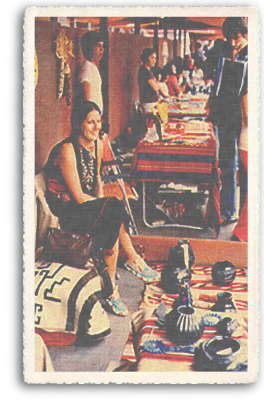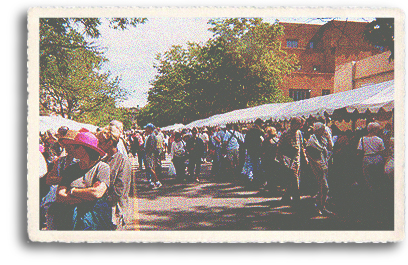 |
||
 Santa Fe Indian Market: World Class Artistry Santa Fe Indian Market: World Class ArtistryThe first Indian Fair, held in 1922, was very different from the massive Indian Market that appeals to an international audience as it does today. Originally organized by the Southwestern Indian Fair Committee, the stated purpose was to revive the traditional techniques and designs of American Indian arts and crafts, which at that time had almost become obsolete. Tourists had become more interested in buying trinket goods as token souvenirs of the Southwest, such as salt and pepper shakers and other trivial items that could be easily packed for their trip back home. The Southwestern Indian Fair Committee was formed in large part by Dr. Edgar Lee Hewett, a well-known anthropologist and director of both the Museum of New Mexico and the School of American Research. He became aware of, and involved in, a program begun by Rose Dougan and Vera von Blumenthal at San Ildefonse Pueblo, which was an effort to revive traditional pottery techniques. By creating the Indian Fair Committee, Hewett hoped to provide an outlet for Indian artists to excel in their work by competing for prizes. Around the same time, the New Mexico Association of Indian Affairs (NMAIA), was formed as a voluntary group to fight the infamous federal Bursum Bill, which would have removed about 60,000 acres of irrigable land in Northern New Mexico (as well as the water rights that went with it) from American Indian control. Through the organization’s lobbying efforts, the bill was defeated. With the awareness that they could do more for American Indians throughout the region, NMAIA moved on to address other problems, such as health care. The group brought in doctors and nurses to areas in need, supplied food in times of drought, and provided legal counsel. In 1923, NMAIA defeated another federal order, which aimed to ban the performance of Pueblo dances. Since they had many of the same goals, the two organizations merged under NMAIA with a dual mission of continuing for further excellence in American Indian arts, as well as involvement in political issues. For the first decade, the Indian Fair was held in conjunction with the Fiesta de Santa Fe. American Indian products were often collected from various tribes by the fair organizers in advance of the event and sold by volunteers who would then disburse the revenues to the artists. It was not until 1931 that the fair organizers began inviting Indian artists to represent their own work at the market. During the early 1930s, the fair underwent another major change. The Indian Fair Committee decided to discontinue the annual fair in Santa Fe and instead sent judges to the Pueblos, which were encouraged to hold their own events. But this plan did not prove to be beneficial to the quality of work or the financial revenues for the participating tribes.  By the mid-1930s, newly elected chairwoman of the NMAIA, Margretta Dietrich, persuaded the organization to continue the Indian Fair in Santa Fe during the annual Fiesta. Because the market continued to grow, fair organizers decided to try something new: Saturday mini-markets, which featured a “Pueblo of the Week.” By the mid-1930s, newly elected chairwoman of the NMAIA, Margretta Dietrich, persuaded the organization to continue the Indian Fair in Santa Fe during the annual Fiesta. Because the market continued to grow, fair organizers decided to try something new: Saturday mini-markets, which featured a “Pueblo of the Week.”During the summer of of 1936, Indian artists from a designated Pueblo came to Santa Fe each Saturday to sell their wares under the portal of the Palace of the Governors. These Saturday markets proved to be very successful. The Indian Market and the Saturday fairs continued to flourish until World War II. The Indian Market was eventually moved from Fiesta weekend to its own time slot in August. The parent organization, NMAIA, continued to grow. By the 1960s, its role expanded to include representation of American Indian nations throughout the Southwest, such as the Navajos, Apaches, Utes, Piautes, Pimas Papagos, and Plains and Northwest tribes. It changed its name to Southwestern Association on Indian Affairs. And in 1993, it became the Southwestern Association for Indian Arts (SWAIA). Today, Indian Market showcases about 1,200 area American Indians artists whose mediums include painting, poetry, sculpture, pottery, jewelry, and woven materials. It is Santa Fe’s single largest tourist attraction, drawing an estimated 100,000 visitors annually. Indian Market Awards Indian Market Food Vendors Indian Market Ceremonial Dances |
||
Home | Food | Lodging | Merchants | Services | Real Estate | Art & Galleries | Entertainment | Recreation Ski Areas | Mind-Body-Spirit | Santa Fe Information | Local Color | Canyon Road | The Turquoise Trail | Santa Fe Plaza The Pueblos | Scenic Beauty | Day Trips | Chili | Special Events | Santa Fe History | Multicultures | Museums High Road to Taos | The Wild West | Churches | Plants & Wildlife | Santa Fe Railyard | Turquoise | Architecture Fiesta | Indian Market | Spanish Market | Zozobra | Features | About Us | Get Listed! | Santa Fe Unlimited Trading Post Photo of the Week | Link of the Month | Testimonials | Santa Fe Webcams | Santa Fe Weather Santa Fe A to Z | Movie Locations | Santa Fe Unlimited Guestbook | Sitemap | Contact Us | Taos Unlimited |
||